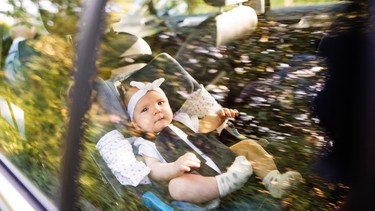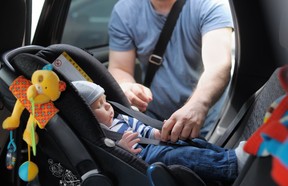

You can save this article by registering for free here. Or sign-in if you have an account.

For first-time parents, researching car seats can feel like learning a new language. There are ages, stages, measurements and charts, and the laws can vary from one jurisdiction to the next. And this goes on for almost 10 years.
Advertisement 2 Story continues below This advertisement has not loaded yet, but your article continues below.Join our thriving community on social media and connect with other car searchers and enthusiasts.
Article content We apologize, but this video has failed to load. Try refreshing your browser, orIt’s a lot to remember. But we’re here to help. Here’s a quick reference guide to the definitions of each of the three stages for child restraints for cars – rear-facing, forward-facing and booster – and the regulations for each of the provinces and territories across Canada, along with a basic set of rules and suggestions all parents should follow. As for managing your kids’ fights when one of them outgrows a booster but the other has to stay in it for a while longer? We can’t help you with those, unfortunately.
There are three established styles, or stages, of car seats for kids. Stage 1 is a rear-facing seat, one which puts the child with their back to the driver so they’re looking out the rear window. This is considered the safest position for young kids as it provides necessary support for their heads and necks, and it’s legally required across Canada for all children from birth until reaching a weight of at least 20 lbs, with most jurisdictions having even more stringent requirements.
Advertisement 3 Story continues below This advertisement has not loaded yet, but your article continues below. Article contentOutside of the law, it’s recommended parents keep their kids in Stage 1 for as long as possible, up until the child outgrows the height and weight restrictions of the rear-facing seat. If you’ve started your infant in a lift-out bucket seat but he outgrows it before reaching your province or territory’s minimum age or weight requirements for moving up, you’ll need to purchase a convertible seat (the type that can be set up both rear- or forward-facing) to use rear-facing until the minimum requirement is met. Stage 2 is a forward-facing seat, which orients the child in the same direction as the rest of the passengers. This type, as with a Stage 1 seat, is equipped with its own five-point harness. This type of seat must always be installed with the rear tether strap in use so that it doesn’t lift away from the car’s seat back in a crash.
Advertisement 4 Story continues below This advertisement has not loaded yet, but your article continues below. Article content Recommended from Editorial Bundle your kids up for winter, but not in their car seats Knowledge is power when it comes to car child seatsStage 3 refers to a booster seat used in conjunction with the car’s built-in seat belt. Again, it’s recommended to put this off for as long as possible because the seat is no longer doing any of the work to keep your child safe at this stage. Rather, the purpose of the booster is to ensure that the seat belt follows the correct path — the shoulder strap needs to sit squarely on the child’s shoulder, not climbing up onto the neck, and the lap belt should fall low across the hips, not higher onto the torso.
It’s therefore critical a child is developmentally ready to make this switch — not only in weight and height, but also behaviour. A kid who can’t be trusted not to pull at or unbuckle a seat belt or tuck the shoulder belt behind their back should remain in a five-point harness until they can be.
Advertisement 5 Story continues below This advertisement has not loaded yet, but your article continues below. Article contentWhen can a child sit in the front passenger seat? A few provinces set the bar at age 12, but Transport Canada recommends kids stay in the back seat until age 13.
These regulations and recommendations are the same across Canada.

Stage 1: from birth to at least one year of age and weighing at least 9 kg (20 lbs).
Stage 2: until weighing at least 18 kg (40 lbs).
Stage 3: until nine years old or 145 cm (4-foot-9-inches), whichever comes first.
Stage 1: from birth until at least two years of age or reach the maximum manufacturer-declared height and weight limit for the rear-facing seat.
Stage 2: until child outgrows maximum manufacturer-declared height and weight limits for forward-facing seat.
Stage 3: until child outgrows maximum manufacturer-declared height and weight limits for booster seat.
Stage 1: from birth to at least one year of age and weighing at least 9 kg (20 lbs). Recommended that the child is able to walk unassisted before moving to forward-facing.
Stage 2: until weighing at least 30 kg (65 lbs).
Stage 3: until seven years old, at least 145 cm (4-foot-9-inches) and at least 36 kg (80 lbs).
Stage 1: from birth until reaching the maximum manufacturer-declared height and weight limit for the rear-facing seat.
Stage 2: until child outgrows maximum manufacturer-declared height and weight limits for the forward-facing seat.
Stage 3: until nine years old, 145 cm (4-foot-9-inches) or 36 kg (80 lbs).
Advertisement 8 Story continues below This advertisement has not loaded yet, but your article continues below. Article content We apologize, but this video has failed to load. Try refreshing your browser, orStage 1: from birth to at least one year of age and weighing at least 9 kg (20 lbs).
Stage 2: children weighing 9 kg to 18 kg (20 to 40 lbs) may use either a forward-facing child car seat or a rear-facing car seat for as long as the car seat manufacturer recommends its use; after that point, use forward-facing until child outgrows maximum manufacturer-declared height and weight limits for the seat.
Stage 3: until eight years old, 145 cm (4-foot-9-inches) or weighing 36 kg (80 lbs).
Stage 1: from birth to at least one year of age, at least 10 kg (22 lbs), and able to maintain an upright position unassisted.
Stage 2: until at least 18 kg (40 lbs).
Stage 3: until nine years of age or 145 cm (4-foot-9-inches). Recommended to continue booster use until child’s legs are long enough to bend over the front edge of the seat, even if these minimums are met.
Advertisement 9 Story continues below This advertisement has not loaded yet, but your article continues below. Article contentStage 1: from birth to at least one year of age and at least 10 kg (22 lbs).
Stage 2: until at least 18 kg (40 lbs).
Stage 3: until nine years of age, 36 kg (79 lbs) or 145 cm (4-foot-9-inches).
Stage 1: from birth to at least one year of age and at least 10 kg (22 lbs).
Stage 2: until at least 18 kg (40 lbs).
Stage 3: until nine years of age or 145 cm (4-foot-9-inches).
Stage 1: from birth to at least one year of age and weighing at least 10 kg (22 lbs).
Stage 2: until at least 18 kg (40 lbs).
Stage 3: until nine years of age or 145 cm (4-foot-9-inches).

Stage 1: from birth to at least one year of age and at least 9 kg (20 lbs).
Stage 2: until at least 18 kg (40 lbs).
Stage 3: until nine years of age, 37 kg (81.5 lbs), or 145 cm (4-foot-9-inches).
Advertisement 10 Story continues below This advertisement has not loaded yet, but your article continues below. Article contentStage 1: from birth to at least 10 kg (22 lbs) and walking unassisted.
Stage 2: until at least 22 kg (48 lbs).
Stage 3: until at least 45 kg (100 lbs) or 145 cm (4-foot-9-inches).
Stage 1: from birth to at least one year of age and at least 9 kg (20 lbs).
Stage 2: until at least 18 kg (40 lbs).
Stage 3: until at least 36 kg (80 lbs) or 145 cm (4-foot-9-inches).
Stage 1: from birth to at least 9 kg (20 lbs).
Stage 2: until at least 18 kg (40 lbs).
Stage 3: no territorial regulation.
Sign up for our newsletter Blind-Spot Monitor and follow our social channels on Instagram ,Facebook and X to stay up to date on the latest automotive news, reviews, car culture, and vehicle shopping advice.
More in More FeaturesStephanie Wallcraft is a full-time professional freelance writer and content creator based in Toronto. Her areas of automotive expertise include new vehicle reviews, consumer information and purchasing advice, family-friendly transportation, motorsport, and road trip travel. Stephanie has been a contributor to Driving.ca since 2019.
- A 10-year freelance automotive writing career with bylines in major Canadian and U.S.-based publications - Expertise in new vehicle reviews, consumer information and purchasing advice, family-friendly transportation, motorsport, and road trip travel - Served for six years on the Board of Directors for the Automobile Journalists Association of Canada, including as the first woman to hold the role of President (2019-2022)
Stephanie graduated from high school at Turner Fenton Campus in Brampton, and from Seneca College with a diploma in Radio and Television Broadcasting. The latter included focused training in broadcast journalism. But the education that led her into a career in automotive journalism started as a young girl in the grandstands of the Honda Indy Toronto and continued in the press rooms of the NTT IndyCar Series and Canadian Tire Motorsport Park.
When deciding to attend Seneca College for training in broadcasting, Stephanie had a singular goal: to graduate and get a job as a motorsport pit reporter. What she failed to calculate into her plans was that there was precisely one pit reporting job in all of Canada at the time, and it was a part-time gig at best. Upon realizing that ambition wasn’t in the cards, she spent roughly 15 years working traditional office jobs, 12 of which were with major law firms in downtown Toronto. This valuable period of her career taught her the importance of precision in the written word and diplomacy in the workplace. Her passion for fast machines on four wheels never wavered, and over time she began writing and podcasting on the side for a website she co-owned focused on IndyCar racing. She became a regular on the circuit, self-funding her way to eight to ten races per year and delivering to-the-minute coverage on her website as well as the platform formerly known as Twitter. This is how she captured the attention of Canadian Motorsport Hall of Fame inductee Norris McDonald, who offered her an opportunity to place her byline in one of Canada’s premier automotive newspaper sections. She left her office job six months later and hasn’t looked back. In addition to Driving.ca, Stephanie’s automotive-related work has appeared in the Wheels section of the Toronto Star, CarGurus Canada, AutoTrader.ca, lifestyle magazines such as NUVO, MONTECRISTO, SHARP, and Corporate Knights, industry publications including Supply Professional magazine and Automotive News Canada, and elsewhere. Stephanie also runs the automotive-focused YouTube channel Modern Motoring with her partner, Jay Kana, and owns and operates RoadTripper.ca, a website dedicated to Canadian road trip travel. On top of her automotive work, she regularly produces content relating to food and drink-related topics.
Runner-up: AJAC 2022 Jaguar Land Rover Canada Journalist of the Year Winner: AJAC 2022 Vinfast Canada Adventure and Travel Journalism Award Winner: AJAC 2022 Volvo Car Canada Road Safety Journalism Award Runner-up: AJAC 2022 Kal Tire Business Journalism Award Runner-up: AJAC 2021 Adventure and Travel Journalism Award Winner: AJAC 2020 Canadian Tire Motorsport Park Julie Wilkinson Motorsport Journalism Award Winner: AJAC 2019 Canadian Tire Motorsport Park Julie Wilkinson Motorsport Journalism Award Winner: AJAC 2017 Nissan Canada Environmental Journalism Award Winner: AJAC 2017 CAA Road Safety Journalism Award Winner: AJAC 2015 Bridgestone Canada Feature Writing Award